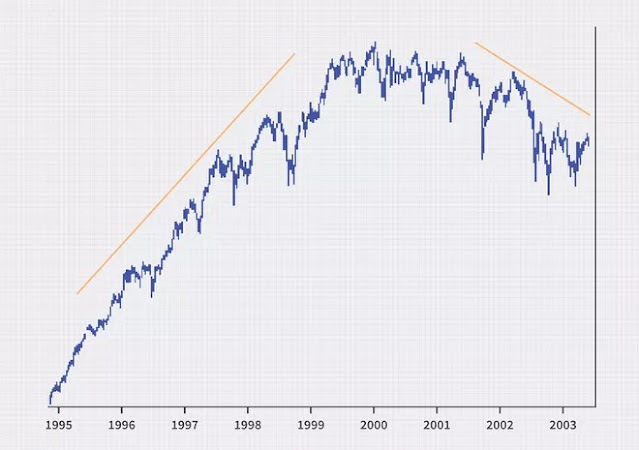Identifying Market Trends
Simply put, short-, intermediate- and long-term trends are the three kinds of trends that we see each day in our study of technical analysis. "A trend is your friend," is just one of the sayings that have come out of the study of primary as well as secular trends.
Some people try to identify trends by looking at averages. Given the understanding that the psychology of the markets actually moves the markets, we can acknowledge that psychology develops and ends the trends we are going to look at today.
Learning how to identify the trend should be the first order of business for any student of technical analysis. Most investors, once invested in an uptrend, will stay there looking for any weakness in the ride up, which is the indicator needed to jump off and take the profit.
Primary Markets
The bull and bear markets are also known as primary markets; history has shown us that the length of these markets generally lasts from one to three years in duration.
Secular Trends
A secular trend, one that can last for one to three decades, holds within its parameters many primary trends, and, for the most part, is easy to recognize because of the time frame. The price-action chart, for a period of 25 years or so, would appear to be nothing more than a number of straight lines moving gradually up or down
Have a look for a moment at the chart of the S&P 500 below. The chart shows the progress of the markets from the 1980s through the mid-2000s, showing the rise of the market leading up to the turn of the century.
Intermediate-Trends
Within all primary trends are intermediate trends, which keep the business journalists and market analysts constantly searching for the answers for why an issue or a market suddenly turns and heads in the direction opposite to that of yesterday or last week. Sudden rallies and directional turnarounds make up the intermediate trends and, for the most part, are the results of some kind of economic or political action and its subsequent reaction.
History tells us that the rallies in bull markets are strong and that the reactions are somewhat weak. The flip side of the coin shows us that bear-market reactions are strong and that the rallies are short. Hindsight also shows us that each bull and bear market will have at least three intermediate cycles. Each intermediate cycle could last as little as two weeks or as long as six to eight weeks.
Long-Term Trends
To determine the long-term trends that appear on the charts of their favorite stocks, veteran analysts will use a stochastics indicator. My favorite, however, is the momentum indicator called the rate of change (ROC) (which you can read about in Rate of Change):
The normal time frame for ROC measurement is 10 days. The ratio to build the ROC indicator is as follows:
Rate of Change = 100 (Y/Yx)
"Y" represents the most recent closing price, and Yx represents the closing price a specific number of days ago. So, if the price of a stock closes higher today than it did 10 days ago, the ROC value point will be above the equilibrium, thus indicating to chartists that prices are rising in that particular issue.
Conversely, if the price in today's session closes lower than it did 10 trading days ago, the value point will be below the equilibrium, indicating that prices are falling off. It is safe to say that if the ROC is rising, it gives a short-term bullish signal, and a bearish sign would have the ROC falling.
Chartists pay great attention to the time period in the calculation of ROC. Long-term views of the market or a specific sector or stock, will use perhaps a 26- to 52-week time period for Yx and a shorter view would use 10 days to six months or so.
You can see that, by changing the number of days or weeks as a time frame, the chartist can better determine the direction and duration of the trend.
The Bottom Line
Markets are made up of several different kinds of trends, and it is the recognition of these trends that will largely determine the success or failure of your long and short-term investing.


Comments
Post a Comment